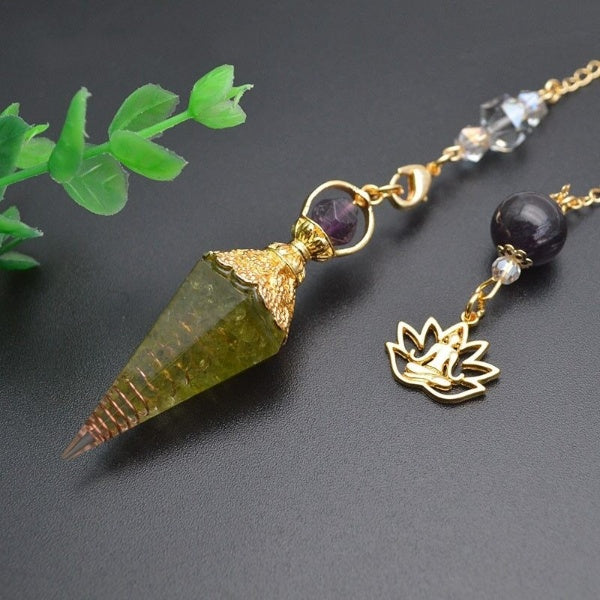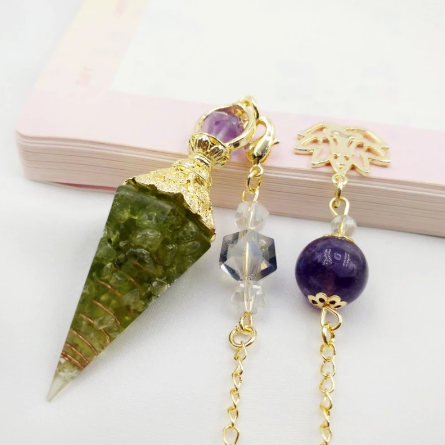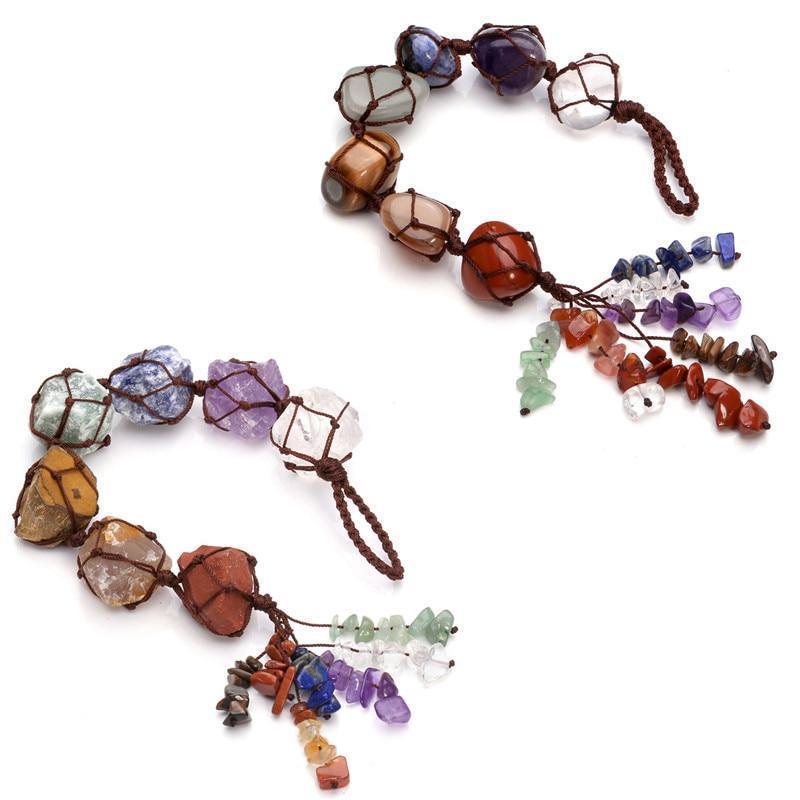Haben Sie schon einmal einen subtilen Drang verspürt, die unsichtbaren Energien zu verstehen, die in Ihnen fließen? Für viele spirituelle Suchende und Wellness-Enthusiasten führt die Reise zur Selbsterkenntnis oft zur Erforschung der Energiezentren des Körpers, der Chakren. Ein wirkungsvolles und intuitives Hilfsmittel für diese Erkundung ist das Chakrenpendel , eine uralte Wünschelrutenmethode, die Ihnen hilft, sich mit Ihrer inneren Energielandschaft zu verbinden. Dieser Leitfaden führt Sie durch alles, was Sie wissen müssen, um Ihre Chakra-Pendel-Heilungsreise zu beginnen und einen wunderschönen Kristall in ein bedeutungsvolles Instrument für Gleichgewicht und Erkenntnis zu verwandeln.
Die Arbeit mit einem Pendel kann sich anfühlen, als würde man eine neue Sprache lernen – die Sprache der eigenen Energie. Es ist eine Praxis, die Intuition mit fokussierter Absicht verbindet und es Ihnen ermöglicht, Ungleichgewichte zu erkennen und Ihr spirituelles Wohlbefinden zu fördern. Egal, ob Sie neu in der Energiearbeit sind oder Ihre bestehende Praxis vertiefen möchten, dieser Leitfaden bietet klare, praktische Schritte, die Ihnen helfen, Ihre Chakren sicher zu überprüfen und auszugleichen.
Was ist ein Chakra-Pendel und wie funktioniert es?
Ein Chakra-Pendel ist typischerweise ein gewichtetes Objekt, oft ein Kristall, das an einer Kette oder Schnur hängt. Es fungiert als Empfänger und Sender von Energie und reagiert auf subtile Schwingungen und Schwankungen im Energiefeld des Körpers. Wenn man ein Pendel über ein Chakra hält, soll es sich auf bestimmte Weise bewegen, die den Zustand dieses Energiezentrums widerspiegeln. Das ist keine Zauberei, sondern eine Möglichkeit, die eigene Intuition und das Unterbewusstsein zu stärken.
Das Pendel nutzt die winzigen, unbewussten Muskelreaktionen Ihres Nervensystems, die von Ihrem inneren Energiezustand beeinflusst werden. Indem Sie das Pendel ruhig halten, lassen Sie diese subtilen Bewegungen in klare, wahrnehmbare Schwingungen umsetzen. Dies macht das Chakra-Pendel zu einem leistungsstarken Biofeedback-Tool, das Ihnen sichtbare Antworten darauf gibt, welche Chakren geöffnet, blockiert oder behandlungsbedürftig sind. Betrachten Sie es als Brücke zwischen Ihrem Bewusstsein und der angeborenen energetischen Weisheit Ihres Körpers.

Vorbereitung auf Ihre Pendelchakra-Sitzung
Bevor Sie beginnen, ist es wichtig, die Voraussetzungen für eine klare und aussagekräftige Lesung zu schaffen. Zur Vorbereitung gehört die Auswahl des richtigen Werkzeugs, die Reinigung von Restenergie und die Schaffung einer ruhigen Umgebung für Ihre Praxis.
Die Wahl Ihres Pendels
Das beste Pendel ist eines, das zu Ihnen passt. Viele Menschen bevorzugen Kristallpendel, da verschiedene Steine einzigartige heilende Eigenschaften besitzen. Amethyst beispielsweise ist bekannt für seine Verbindung zu Intuition und dem Stirnchakra, während Rosenquarz mit dem Herzchakra assoziiert wird. Halten Sie Ihr Pendel bei der Auswahl in der Hand und achten Sie darauf, wie es sich anfühlt. Vertrauen Sie Ihrer Intuition, die Sie zum richtigen Pendel führt. Ein Werkzeug wie das Amethyst-Peridot-Orgonkristallpendel ist perfekt für Anfänger, da es die klärende Energie des Amethysts mit den schützenden Eigenschaften des Peridots verbindet.
Amethyst Peridot Orgon Kristall Pendel
$49.99 $59.99
Erhöhen Sie Ihre Chakra-Lesungen und Heilrituale mit diesem Amethyst- und Peridot-Pendel voller energetischer Klarheit.
Produkt entdeckenReinigen und Programmieren Ihres Pendels
Sobald Sie Ihr Pendel ausgewählt haben, ist es wichtig, es zu reinigen, um gespeicherte Energien freizusetzen. Sie können es mit Salbei bestreichen, über Nacht im Mondlicht liegen lassen oder auf eine Selenit-Ladeplatte legen. Nach der Reinigung müssen Sie es programmieren, indem Sie seine individuellen Reaktionen bestimmen.
- Halten Sie das Pendel und bitten Sie es, „Ja“ anzuzeigen. Beobachten Sie die Richtung, in die es schwingt (z. B. im Uhrzeigersinn, vorwärts und rückwärts).
- Bitten Sie es als Nächstes, Ihnen „Nein“ zu zeigen. Beachten Sie diese Bewegung.
- Bitten Sie abschließend um ein „Vielleicht“- oder „Unklar“-Signal.
Dieser Kalibrierungsprozess schafft ein klares Kommunikationssystem zwischen Ihnen und Ihrem Tool und stellt sicher, dass Sie den erhaltenen Antworten vertrauen können.
Einen heiligen Raum schaffen
Suchen Sie sich einen ruhigen, gemütlichen Ort, an dem Sie ungestört sind. Sie können eine Kerze anzünden, Räucherstäbchen verbrennen oder beruhigende Musik spielen. Atmen Sie ein paar Mal tief durch, um sich zu zentrieren, und formulieren Sie eine klare Absicht für die Sitzung, z. B.: „Meine Absicht ist es, Klarheit über den Zustand meiner Chakren zu gewinnen, zu meinem höchsten Wohl.“
So überprüfen Sie Ihre Chakren mit einem Pendel: Eine Schritt-für-Schritt-Anleitung
Nachdem Sie Ihr Pendel gereinigt und Ihren Raum vorbereitet haben, können Sie mit der Chakren-Untersuchung beginnen. Sie können dies im Liegen tun, um alle sieben Energiezentren Ihres Körpers leicht zu erreichen. Einen umfassenden Überblick über das Chakrensystem erhalten Sie in Quellen wie dem Yoga Journal-Leitfaden für Anfänger .
- Erden Sie sich: Atmen Sie ein paar Mal tief durch und zentrieren Sie sich. Stellen Sie sich vor, wie Wurzeln von Ihrem Körper tief in die Erde reichen und Ihre Energie verankern.
- Kalibrieren Sie Ihr Pendel: Halten Sie Ihr Pendel und bitten Sie es, Ihnen noch einmal „Ja“ und „Nein“ anzuzeigen, um zu bestätigen, dass Ihre Verbindung klar ist.
- Positionieren Sie das Pendel: Beginnen Sie mit dem Wurzelchakra an der Basis Ihrer Wirbelsäule. Halten Sie das Pendel an der Kette oder dem Anhänger zwischen Daumen und Zeigefinger und lassen Sie es etwa 2,5 cm über dem Chakra baumeln. Halten Sie Ihre Hand so ruhig wie möglich.
- Stellen Sie Ihre Frage: Stellen Sie mündlich oder im Geiste eine klare Frage, beispielsweise: „Ist mein Wurzelchakra offen und ausgeglichen?“ Bleiben Sie offen und empfänglich für die Antwort.
- Beobachten und Interpretieren: Lassen Sie das Pendel frei schwingen. Achten Sie auf Richtung und Intensität, ohne Einfluss zu nehmen. Sobald Sie ein klares Ergebnis erhalten, danken Sie dem Pendel und gehen Sie zum nächsten Chakra (Sakral-, Solarplexus-, Herz-, Hals-, Drittes Auge- und Kronenchakra).

Zur visuellen Demonstration dieses Vorgangs bietet das folgende Video eine hervorragende Schritt-für-Schritt-Anleitung zum richtigen Halten und Interpretieren der Pendelbewegungen über jedem Chakra.
Pendelbewegungen über Chakren interpretieren
Das Verständnis der Pendelbewegungen ist der Schlüssel zu Ihrer Praxis. Obwohl die Interpretationen individuell sein können, gibt es einige allgemein anerkannte Bedeutungen für die verschiedenen Schwingungen. Es ist hilfreich, ein Tagebuch zu führen, um Ihre Erkenntnisse zu dokumentieren und im Laufe der Zeit Muster zu erkennen.
Gängige Pendelbewegungen und ihre Bedeutung:
- Starker Kreis im Uhrzeigersinn: Zeigt ein offenes, starkes und ausgeglichenes Chakra mit harmonischem Energiefluss an. Dies ist ein positives Zeichen.
- Starker Kreis gegen den Uhrzeigersinn: Deutet oft darauf hin, dass Energie freigesetzt wird oder dass eine Blockade aufgrund vergangener Erfahrungen oder emotionaler Muster vorliegt, die gelöst werden muss.
- Seitliche oder Vorwärts- und Rückwärtsbewegungen: Diese linearen Bewegungen können auf ein horizontales oder vertikales Ungleichgewicht hinweisen. Sie können darauf hindeuten, dass der Energiefluss in bestimmte Richtungen blockiert ist.
- Schwache oder unregelmäßige Bewegung: Dies kann auf einen erschöpften oder inkonsistenten Energiefluss im Chakra hinweisen. Es kann teilweise blockiert sein oder Probleme haben.
- Keine Bewegung: Ein völlig stillstehendes Pendel weist oft auf eine erhebliche Blockade oder Ruhe im Chakra hin, was bedeutet, dass es derzeit Energie nicht effektiv verarbeitet.
Diese Infografik bietet eine schnelle visuelle Referenz für den gesamten Prozess, von der Reinigung Ihres Pendels bis zur Interpretation seiner Signale über Ihre Chakren.

[Sammlungs-Schieberegler]
Verbessern Sie Ihre Praxis mit diesen Tools
Wenn Sie Ihre Pendelarbeit vertiefen, können Sie weitere Hilfsmittel zur Unterstützung Ihrer Energieausgleichs- und Reinigungsrituale einsetzen. Kristalle und Edelsteine sind mächtige Verbündete, die Ihre Aura reinigen und Ihre Absichten verstärken können, wodurch ein ganzheitlicheres Heilungserlebnis entsteht.
Wichtige Werkzeuge für den Chakra-Ausgleich
$19.99
$29.99
Reinigen Sie Ihre Aura und erhalten Sie klare Antworten, während Sie mit diesem wunderschön facettierten Opalkristallpendel die Chakren durchleuchten. Mehr erfahren ➔
$69.99
$89.99
Bringen Sie Farbe und Harmonie in Ihren Raum und arbeiten Sie mit den Chakren, indem Sie mit diesen dekorativen Steinen Energie ausgleichen und Ihre Absichten festlegen. Mehr erfahren ➔
Fazit: Ihre Reise zur energetischen Harmonie
Die Arbeit mit einem Pendel für die Chakren ist eine zutiefst persönliche und kraftvolle Praxis. Sie bietet eine direkte Verbindung zu den subtilen Energien Ihres Körpers und gibt Ihnen die Kraft, Ihr eigenes Wohlbefinden einzuschätzen, zu verstehen und zu fördern. Wenn Sie diese Schritte befolgen, können Sie dieses einfache Werkzeug in einen wichtigen Verbündeten für spirituelles Wachstum und Selbstheilung verwandeln. Denken Sie daran, dass Beständigkeit und Absicht entscheidend sind. Je mehr Sie üben, desto stärker wird Ihre Verbindung und desto mehr vertrauen Sie der Weisheit, die durch Sie fließt.
Begeben Sie sich mit offenem Herzen und neugierigem Geist auf die Reise. Lassen Sie sich von Ihrem Pendel zu mehr Gleichgewicht, Klarheit und Harmonie in Ihrem gesamten Energiesystem führen. Beginnen Sie noch heute mit der Erkundung und entdecken Sie eine neue Dimension der Selbstfürsorge.
Häufig gestellte Fragen zur Pendelchakra-Heilung
Um Ihre Chakren zu überprüfen, reinigen und programmieren Sie zunächst Ihr Pendel, um „Ja“ und „Nein“ zu reagieren. Legen Sie sich bequem hin und halten Sie das Pendel etwa 2,5 cm über Ihrem Wurzelchakra. Fragen Sie sich: „Ist dieses Chakra im Gleichgewicht?“ und beobachten Sie die Bewegung. Eine Schwingung im Uhrzeigersinn bedeutet in der Regel „Ja“ oder „Ausgeglichenheit“, während eine gegen den Uhrzeigersinn oder eine statische Bewegung auf eine Blockade hinweisen kann. Wiederholen Sie diesen Vorgang für alle sieben Chakren.
Ein 7-Chakra-Pendel enthält oft Edelsteine, die den sieben Chakren entsprechen. Es wird hauptsächlich zum Wünschelrutengehen, zur Diagnose und zum Ausgleich der Energiezentren des Körpers verwendet. Die kombinierten Energien der verschiedenen Steine machen es zu einem besonders kraftvollen und vielseitigen Werkzeug für ganzheitliche Heilung, Reiki und Energieanalyse, da es gleichzeitig mit dem gesamten Chakra-System in Resonanz tritt.
Ja, Pendel wirken auf spiritueller und intuitiver Ebene. Sie fungieren als Erweiterung Ihrer eigenen Intuition und verstärken subtile Energieverschiebungen und unterbewusstes Wissen. Ein Pendel hat keine eigene Kraft; stattdessen reagiert es auf Ihr Energiefeld und die universellen Energien um Sie herum und ist somit ein mächtiges Werkzeug, um sich mit Ihrem höheren Selbst, spirituellen Führern und Ihrer inneren Weisheit zu verbinden.
Um die Energie zu überprüfen, halten Sie Ihr kalibriertes Pendel über einen Gegenstand, eine Person oder ein Energiezentrum (Chakra). Setzen Sie sich eine klare Absicht und stellen Sie eine Frage, wie zum Beispiel: „Ist die Energie hier positiv und fließt sie?“ oder „Ist dieses Essen gesund für mich?“ Das Pendel reagiert mit seinen programmierten „Ja“- oder „Nein“-Bewegungen und gibt Ihnen Einblick in den energetischen Zustand des zu untersuchenden Objekts.
Chakra-Pendel reagieren auf die subtilen elektromagnetischen Felder Ihrer Chakren. Wenn Sie das Pendel über ein Chakra halten, interagiert es mit dieser spezifischen Energiefrequenz. Die resultierende Schwingung – ihre Richtung, Form und Intensität – ist eine physische Manifestation des Chakra-Zustands und zeigt an, ob es ausgeglichen, überaktiv, unteraktiv oder blockiert ist. Es übersetzt im Wesentlichen energetische Informationen in sichtbare Bewegung.







